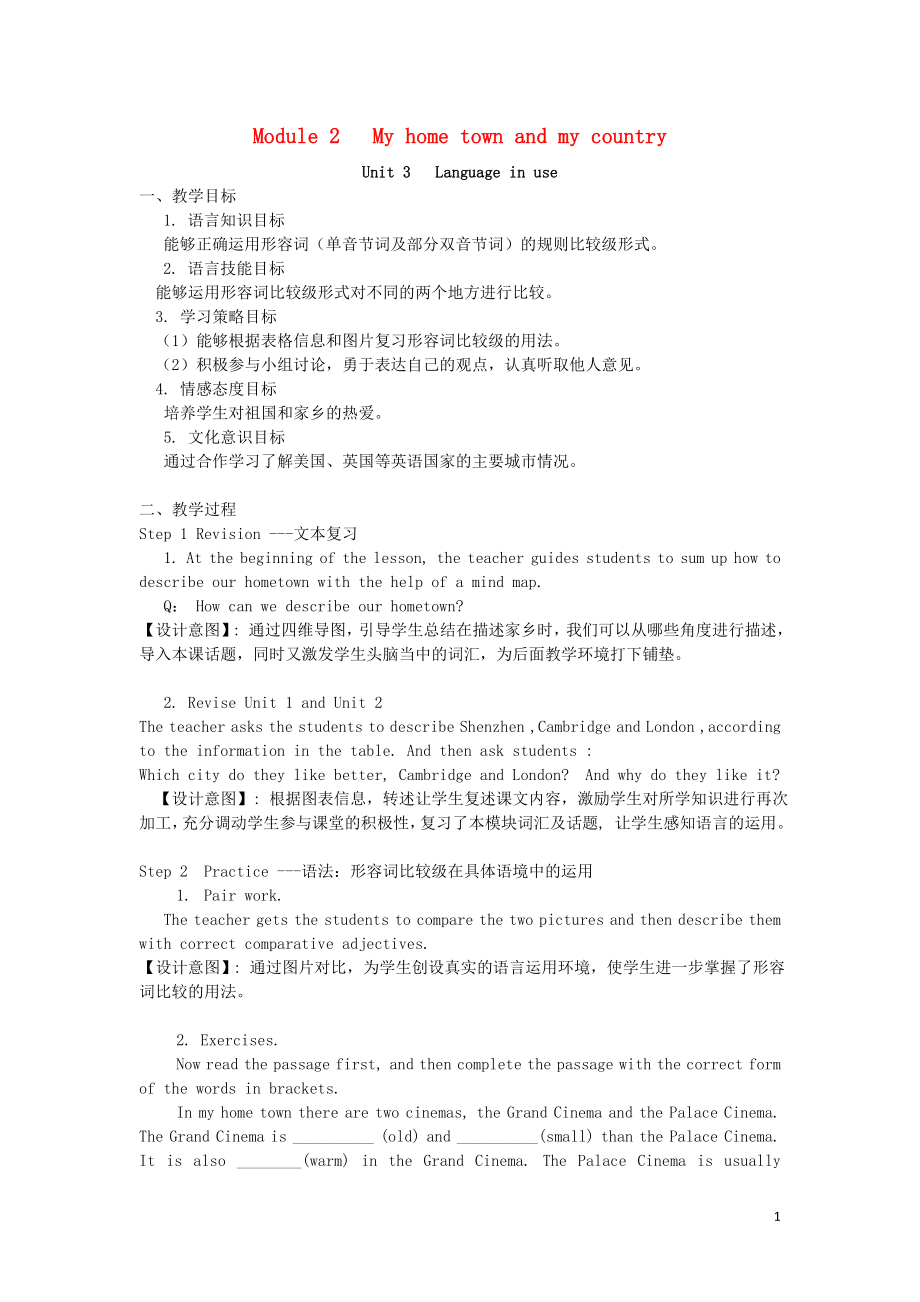《2019學(xué)年八年級英語上冊 Module 2 My home town and my country Unit 3 Language in use教案 (新版)外研版》由會員分享����,可在線閱讀�����,更多相關(guān)《2019學(xué)年八年級英語上冊 Module 2 My home town and my country Unit 3 Language in use教案 (新版)外研版(3頁珍藏版)》請在裝配圖網(wǎng)上搜索��。
1�����、Module 2 My home town and my country
Unit 3 Language in use
一�、教學(xué)目標(biāo)
1. 語言知識目標(biāo)
能夠正確運(yùn)用形容詞(單音節(jié)詞及部分雙音節(jié)詞)的規(guī)則比較級形式。
2. 語言技能目標(biāo)
能夠運(yùn)用形容詞比較級形式對不同的兩個地方進(jìn)行比較�。
3. 學(xué)習(xí)策略目標(biāo)
(1)能夠根據(jù)表格信息和圖片復(fù)習(xí)形容詞比較級的用法。
(2)積極參與小組討論�,勇于表達(dá)自己的觀點(diǎn),認(rèn)真聽取他人意見���。
4. 情感態(tài)度目標(biāo)
培養(yǎng)學(xué)生對祖國和家鄉(xiāng)的熱愛�。
5. 文化意識目標(biāo)
通過合作學(xué)習(xí)了解美國�����、英國等英語國家的主要城市情況。
二��、教學(xué)
2�、過程
Step 1 Revision ---文本復(fù)習(xí)
1. At the beginning of the lesson, the teacher guides students to sum up how to describe our hometown with the help of a mind map.
Q: How can we describe our hometown?
【設(shè)計意圖】: 通過四維導(dǎo)圖,引導(dǎo)學(xué)生總結(jié)在描述家鄉(xiāng)時�����,我們可以從哪些角度進(jìn)行描述�,導(dǎo)入本課話題�����,同時又激發(fā)學(xué)生頭腦當(dāng)中的詞匯�,為后面教學(xué)環(huán)境打下鋪墊。
2. Revise Unit 1 and
3�、 Unit 2
The teacher asks the students to describe Shenzhen ,Cambridge and London ,according to the information in the table. And then ask students :
Which city do they like better, Cambridge and London? And why do they like it?
【設(shè)計意圖】: 根據(jù)圖表信息,轉(zhuǎn)述讓學(xué)生復(fù)述課文內(nèi)容���,激勵學(xué)生對所學(xué)知識進(jìn)行再次加工�,充分調(diào)動學(xué)生參與課堂的積極性����,復(fù)習(xí)了本模塊詞匯
4�����、及話題, 讓學(xué)生感知語言的運(yùn)用���。
Step 2 Practice ---語法:形容詞比較級在具體語境中的運(yùn)用
1. Pair work.
The teacher gets the students to compare the two pictures and then describe them with correct comparative adjectives.
【設(shè)計意圖】: 通過圖片對比,為學(xué)生創(chuàng)設(shè)真實(shí)的語言運(yùn)用環(huán)境�����,使學(xué)生進(jìn)一步掌握了形容詞比較的用法�。
2. Exercises.
Now read the passage first, and then
5、complete the passage with the correct form of the words in brackets.
In my home town there are two cinemas, the Grand Cinema and the Palace Cinema. The Grand Cinema is __________ (old) and __________(small) than the Palace Cinema. It is also ________(warm) in the Grand Cinema. The Palace Cinema is
6����、 usually ________(busy) than the Grand Cinema and the tickets are ______________(cheap), too.
【設(shè)計意圖】:在經(jīng)過一系列口頭輸出之后,通過習(xí)題練習(xí)�,讓學(xué)生更好地掌握本模塊的語法形容詞比較級的應(yīng)用。同時也為學(xué)生如何對兩個地方進(jìn)行比較提供素材�����。
3. Listening practice
1. Listen to the tape and answer the question.
What cities are mentioned in the dialogue?
2. Listen to
7�����、the tape and fill in the blanks.
(1). New York is a(n) ______ and ______ city than Washington D.C.
(2). New York is more __________ than any other city in the US.
(3). Shanghai has a(n) ______ population than Beijing.
(4). Beijing is _______ than Shanghai.
【設(shè)計意圖】通過聽錄音,獲取主要信息��,讓學(xué)生從聽覺上感知語言的運(yùn)用�����,加深了對
8����、形容詞比較運(yùn)用的理解,為后面的語言運(yùn)用環(huán)節(jié)做好了準(zhǔn)備�。
Step 4 writing
1. pre-writing
Show pictures of two places in Dalian and get students talk about them .
Qs: What places are they?
Which place do you like better? And why?
2.Whilei-writing
First ,ask 2 or 3 students to sum up the reasons why they like People’s S
9��、quare or Xinghai Square, and then get them write down the reasons.
【設(shè)計意圖】通過討論����,激勵學(xué)生對所學(xué)知識進(jìn)行再次加工轉(zhuǎn)述,在圖片的幫助下�,先讓學(xué)生對兩個地方逐一進(jìn)行口頭對比,然后讓學(xué)生以書面形式列出理由�,通過此練習(xí),已達(dá)到對將本模塊所學(xué)的內(nèi)容的表達(dá)以及適當(dāng)?shù)匕研稳菰~比較級運(yùn)用到話題任務(wù)當(dāng)中���,為課后寫作坐下鋪墊�����。
Step 5. Homework
Compare People’s Square and Xinghai Square, which do you like better and why do you
10�����、like it? Write a passage about it?
【設(shè)計意圖】作業(yè)是課堂學(xué)習(xí)的延伸和鞏固�,是所學(xué)知識的反饋, 讓學(xué)生在作業(yè)布置中再次體會到形容詞比較級在具體的語境中的運(yùn)用。
三�、教學(xué)反思
這節(jié)課的主題是英語初中二年級上冊Module Two My home town and my country Unit Three Language in use。本節(jié)課的教學(xué)目的主要有二個:1.能夠正確運(yùn)用形容詞(單音節(jié)詞及部分雙音節(jié)詞)的規(guī)則比較級形式��。2.能夠運(yùn)用形容詞比較級形式對不同的兩個地方進(jìn)行比較��。教學(xué)的過程我主要通過任務(wù)型活動展開�����。為了實(shí)現(xiàn)教學(xué)目標(biāo)��,我設(shè)計多種教學(xué)活動��,組織學(xué)生開展討論。整個活動都圍繞形容詞比較級用法展開����,使學(xué)生掌握其用法。
通過本課的教學(xué)����,我深有感觸。首先�,教學(xué)永遠(yuǎn)是一門無止境的藝術(shù)。無論怎樣構(gòu)思教學(xué)���,總有需要我們進(jìn)一步改進(jìn)的地方�,它需要我們充分了解教材����、了解學(xué)生,需要我們踏踏實(shí)實(shí)地考慮好每一個環(huán)節(jié)����,這樣每一節(jié)課堂才會是高效率的���,才能真正做到向課堂要質(zhì)量����、向環(huán)節(jié)要質(zhì)量、向態(tài)度要質(zhì)量�。
3
 2019學(xué)年八年級英語上冊 Module 2 My home town and my country Unit 3 Language in use教案 (新版)外研版
2019學(xué)年八年級英語上冊 Module 2 My home town and my country Unit 3 Language in use教案 (新版)外研版

